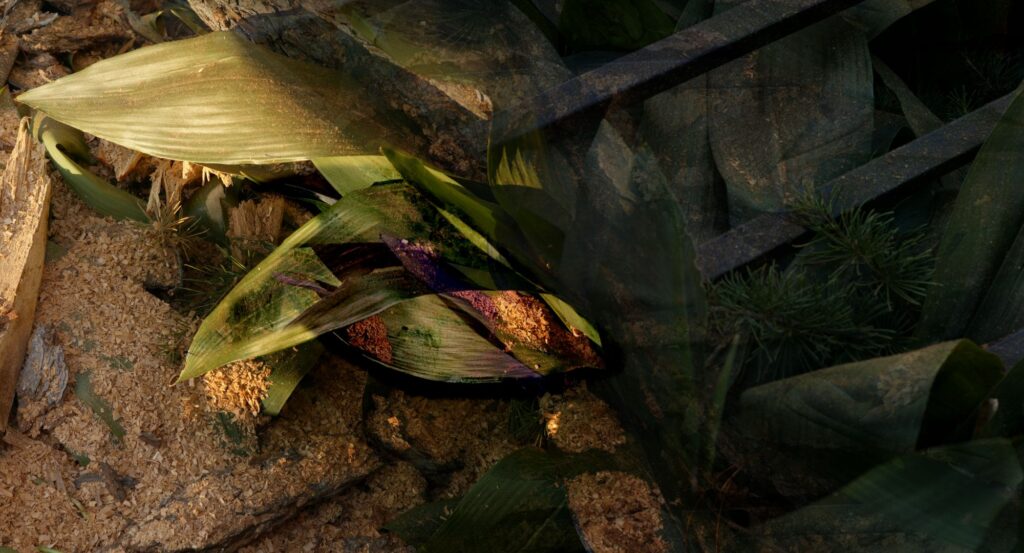On View: September 8 – October 16, 2025
Opening Reception: Friday, September 19 at 5:00 – 7:00 PM | Oresman Gallery, Hillyer
Artist Talk: Thursday, September 25 at 5:00 PM | Graham Hall, Hillyer

This video installation examines the convergence of personal and environmental transformation through the dual lens of queer identity and the impacts of Hurricane Helene in the Central Savannah River Area (CSRA). The layered footage of the artist’s hometown from before, during, and after the hurricane serves as an analogy for William’s own coming-out and evolving relationship to home. Sculptures made from reclaimed storm debris create a meditation on disruption, exploring how climate change has rendered the global intimate and immediate, and what it means to call a place home in an era when environmental crisis has become inescapably personal.
The installation’s conceptual framework emerges from sustained observation of parallel processes of reconstruction: the queer trajectory of realizing authentic selfhood and the climactic upheaval that reshaped much of the Southeastern landscape in September 2024. Hurricane Helene, supercharged by climate change, represented a new paradigm of environmental violence—a Category 4 storm that gained unprecedented strength from ocean waters made up to 500 times more likely to reach such extreme temperatures by human-caused warming. The storm’s rapid intensification from Category 1 to Category 4 in just 24 hours exemplifies how climate change has collapsed traditional boundaries between global and local, distant threat and immediate crisis.
This work considers the painful dismantling of inherited structures that no longer serve, the deliberate construction of new forms of support and belonging, and the recognition that living in the present moment requires the courage to rebuild home according to one’s actual values rather than imposed expectations.
The video work unfolds across different temporal scales: while pre-storm sequences and post-storm footage capture the profound loss of familiar forms, layered images incorporating vibrant colors and experimental media create new possibilities for life. This temporal progression mirrors the phenomenology of queer self-realization—the growing awareness that inherited patterns no longer fit, bearing witness to what has been lost while gesturing toward emergent possibilities.
The installation integrates salvaged materials from Helene’s destruction, augmented through CNC routing, laser cutting, and traditional hand-building techniques. The materiality itself embodies the central thesis: that growth and authenticity often require the painful dismantling of protective but ultimately constraining structures, and that the debris of destroyed systems can become the foundation for more honest and sustainable forms of belonging.
In positioning the CSRA’s storm-transformed landscape as a metaphor for personal transformation, the work suggests that both climate change and queer emergence operate as forces of radical honesty—creating conditions where previously impossible forms of life become not only viable but necessary.
Artist Statement
Marianna Dixon Williams (b. Augusta, GA, 1990) builds handmade electronic objects and develops installations that question themes of identity, environmental change, and the ability of this world to be simulated, emulated, and measured digitally. Their work presents broader conversations regarding world-building, evolving and eroding social systems, and the societal conditions that have impacted our visions for the future as they explore our interconnected relationships with the land, digital life and each other. Williams has exhibited extensively throughout the United States and Europe and has completed projects in sites ranging from the Arctic Circle to South Africa’s Western Cape. Notable exhibitions include The National Museum of Women in the Arts in Washington D.C., the Atlanta Contemporary Art Center, The Oliewenhuis Art Museum at South Africa’s National Museum in Bloemfontein, the James A. Michener Museum, the Noyes Museum Galleries, and the European Cultural Center’s Palazzo Bembo in tandem with the 59th Venice Art Biennale. Williams has acted as a Design Fellow at Penn Praxis, a consultant for Georgia’s Covid-19 Taskforce, an organizer for community-driven arts spaces, and has produced commissioned installations for ShopCore Properties, the Atlanta Botanical Gardens and Berkshire Hathaway Real Estate. Williams is a recipient of a Community Foundation grant and their work has been featured in The Washington Post, the New York Times, and Frieze Magazine. Their writing will be presented as a chapter in the forthcoming book, Oceans, Seas and Shorelines: Natural, Cultural and Environmental Histories, edited by Amin Heidari, Viv Westbrook & Mark Nicholls, published by Routledge.
Website: www.marianalog.com
You must be logged in to post a comment.